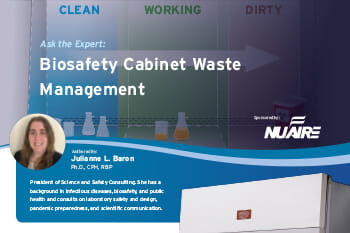
White Paper
Biosafety Cabinet Waste Management
Proper Waste Management in Biosafety Cabinets
Proper waste management in biosafety cabinets (BSCs) is an essential component of laboratory safety. When working with biohazardous materials, waste such as contaminated cultures, sharps, and biological liquids is inevitably generated, presenting potential risks to both personnel and the environment if not handled appropriately. In her expert article, Julianne L. Baron, Ph.D., a recognized authority in biosafety, provides a thorough overview of best practices for waste management within biosafety cabinets. This guide is tailored to those working with biological hazards who need to ensure both regulatory compliance and optimal safety procedures.
Understanding Biosafety Cabinet Waste
Biohazardous waste from biosafety cabinets falls into two primary categories: solid waste and liquid waste. Solid biohazardous waste is further classified into sharps, such as needles, glass, and scalpels, and non-sharps like contaminated plasticware, petri dishes, and disposable pipettes. Each type of waste poses unique containment and disposal challenges within the lab environment, particularly when working within a BSC designed to protect against potentially infectious agents.
Dr. Baron explains that waste containment strategies within the BSC are critical to maintaining a safe workspace and preventing contamination. The BSC’s airflow system, which is vital for protecting users from infectious aerosols, can be disrupted if waste is improperly managed. For instance, reaching outside the BSC to dispose of waste during work can interrupt the delicate air curtain that contains hazardous aerosols. This break in containment not only risks exposure but also allows room air contaminants to enter the cabinet, compromising product sterility.
Waste Containment Within the BSC
To ensure continuous protection, all waste containers should be placed inside the BSC before beginning work. Dr. Baron advises organizing the workspace within the BSC into “clean” and “dirty” zones. The dirty zone is where waste containers are located, allowing for a clear delineation of areas within the BSC to prevent cross-contamination. This strategic layout facilitates a smoother workflow and minimizes the movement that could potentially disrupt airflow.
A primary recommendation is the use of specialized containers designed to fit within the confined space of the BSC while accommodating the specific types of biohazardous waste generated. Autoclave bags for non-sharps and puncture-resistant containers for sharps should be readily available inside the BSC. For liquid biohazardous waste, Dr. Baron suggests using leak-proof containers with secure lids, which can be sealed and removed from the BSC with minimal risk of spillage.
Safe Removal and Disposal of Waste
Once work within the BSC is completed, the next step is to safely remove and dispose of the biohazardous waste. This process requires meticulous attention to avoid compromising the containment and exposure controls that the BSC provides. Dr. Baron describes a step-by-step procedure for waste removal that includes sealing all containers within the cabinet, sanitizing exterior surfaces, and, if necessary, double-bagging materials before transporting them to the appropriate disposal site.
For solid biohazardous waste, this often means sterilizing items via autoclave before disposal. Sharps must be managed with particular care, given their potential to puncture and cause injuries. These items should be placed in a clearly marked, puncture-proof container within the BSC. After sealing, the container can be safely removed and either autoclaved within the facility or disposed of according to the institution’s biohazardous waste protocols.
Liquid biohazardous waste disposal may involve chemical disinfection before removal from the BSC. Dr. Baron advises that personnel responsible for waste management be trained in the correct use of chemical disinfectants, as improper application can render decontamination ineffective. Once disinfected, liquid waste containers should be double-bagged and transported to the waste disposal site.
Importance of Compliance and Training
Dr. Baron emphasizes that, beyond practical handling techniques, proper waste management within BSCs also requires adherence to institutional and governmental regulations. Compliance ensures that labs operate within legal standards while protecting staff and the public from potential biohazard exposure. Regulations from agencies such as the Occupational Safety and Health Administration (OSHA) and the Centers for Disease Control and Prevention (CDC) provide guidelines for handling, storage, and disposal of biohazardous waste.
Routine training for lab personnel is paramount. Dr. Baron notes that ongoing education regarding waste management practices not only reduces the risk of accidents but also reinforces the laboratory’s safety culture. Training should include waste identification, handling procedures, container selection, and emergency protocols for spills or exposure incidents. Personnel must also be proficient in the operation of the BSC itself, as improper use can undermine even the best waste management practices.
Final Thoughts: Maintaining a Safe Lab Environment
Biosafety cabinet waste management is a critical aspect of laboratory safety that protects researchers, their work, and the environment from hazardous exposures. Dr. Baron’s article provides essential insights for anyone working within a BSC, emphasizing that thorough planning, meticulous containment, and diligent disposal practices are key to maintaining effective safety protocols. By following these best practices, labs can prevent contamination, ensure compliance with safety regulations, and create a safer workplace for everyone involved in the handling of biohazardous materials.
For further guidance and expert tips on biosafety cabinet waste management, you can download Dr. Julianne L. Baron’s full article. This resource is ideal for laboratories aiming to improve their waste handling practices and enhance their biosafety protocols, keeping both personnel and the environment safe from the potential risks associated with biohazardous waste.

